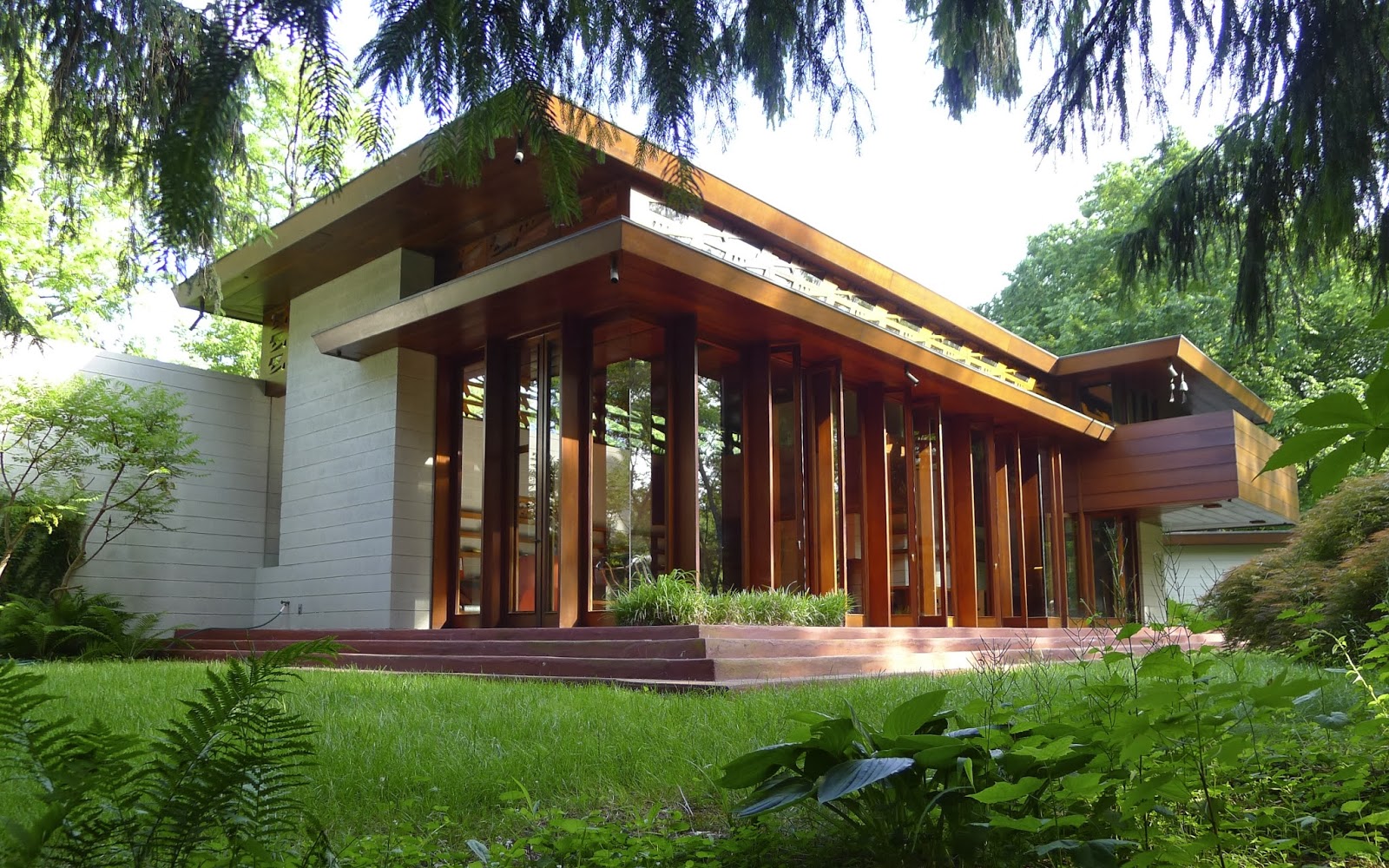Usonian To Go
A Frank Lloyd house is on the move: the Crystal Bridges Museum of American Art is adopting the Bachman Wilson house, moving it from its original flood-prone site in New Jersey to the campus of the Arkansas museum.
 |
| The Bachman Wilson house. ©Tarantino Studio, 2013 |
In keeping with his complex, evolving concept of "organic" architecture, Wright likened his buildings to living things in various ways: he said an organic building should appear to grow "out of the ground and into the light" like a tree; he conceived his buildings with the forms, textures and palette of the natural world; and, like plants and animals, Wright's buildings weren't intended to live forever, as any owner or caretaker of the architect's work will attest. However, unlike many living things, I don't think Wright intended for his buildings to move.
The Bachman Wilson house's upcoming road trip is not unique. In the past, other Usonian houses have been moved in the interest of preservation. The Gordon House was moved about twenty miles within Oregon to save it from demolition, while the Pope-Leighey House of Virginia was moved twice: first to make way for Interstate 66, then again a mere thirty feet to escape unstable soil on the second site. Come to think of it, relocating great structures in general is nothing new. From the incredible exodus of the Abu Simbel temples to make way for the Aswan Dam in Egypt, to the transplantation of the Cape Hatteras lighthouse, moving buildings is an engineering specialty and an industry unto itself. Such monumental moves put the trend of Wright's wandering Usonian homes in perspective.
Still, at risk of blasphemy I must pose this question: why undertake these painstaking relocations when it might be more logical (and cost effective) to build new Usonians at the desired site?
 |
| Bachman Wilson house interior. ©Tarantino Studio, 2013 |
Unlike highly site-specific houses like Fallingwater, Wright conceived of the Usonian houses as appropriate (or at least adaptable) to any topography and clime in North America. And, indeed, they are the most widely distributed of Wright's house types, sprinkled across the country from the Pacific Northwest to New England. In his late career, Wright envisioned Usonian houses on every block, a new vernacular to transform American housing from coast to coast. But Usonians never became the ubiquitous, Everyman home of Wright's ideal. The irony of relocating Usonian houses is this: they're agreeable to moving in that they're modular and fit for a wide range of sites, yet this very neutrality makes them less unique and precious. So why treat them as portable masterpieces?
Of course, I'm opening a Pandora's box of debate here. Matters of material authenticity, craftsmanship and historic patina counter my reckless suggestion that it may be better to replicate rather than relocate. The metaphysical challenge remains: if you break down a house and reassemble it on a new site, is it really the same house? Consider the fact that, once the Usonian concept was introduced, Wright had relatively little personal input on many of these houses at the Taliesin drafting board, and even less at the construction site. The entire process was designed to be reproducible by apprentices with a minimum of input from the elderly Wright. Now consider the fact that Usonians utilized inexpensive, off-the-shelf materials like common red brick, plywood and cinder block - all readily obtained today as they were in the mid twentieth century when the Usonians were built. Finally, consider the fact that Usonian plans were based on a sort of self-propagating geometric grid, and their serial nature comes to the fore. Arguably,
given the design and materials inherent to the Usonian concept, it's
possible to construct a Usonian re-production that's identical to a
"vintage" rendition in every discernible respect. The argument for preserving every component of every Usonian-era house relies on a degree of magical thinking - as if some of Wright's genius rubbed off on every brick and plank he ever touched (not that he touched many).
 | |
| Drawing for Sixty Years of Living Architecture. © 1988 Frank Lloyd Wright Foundation |
I don't mean to suggest that painstaking preservation and restoration of Wright buildings is unimportant. Heroic, high profile restorations like those at Fallingwater and the Martin House deserve their status as models of preservation. But when it comes to the more generic Usonian houses, I wonder whether the public regards them as overly-precious architectural commodities when given the same white glove treatment. Museums and private homeowners alike might be better served to acquire Usonian plans and build their own twenty-first century Usonians. For that matter, I think Wright might be pleased to see the Usonian "brand" extended well past its heyday. For a new homeowner, this would allow for the sort of customization that Wright celebrated to reflect the unique character of the client. For a museum like Crystal Bridges, it would allow for the integration of didactic elements to give visitors a better understanding of a the Usonian concept. After all, Wright himself presented a temporary, model Usonian as a centerpiece of the Sixty Years of Living Architecture: The Work of Frank Lloyd Wright exhibition on the future site of the Guggenheim (1953).
For two examples of refugee architecture in a museum setting, you don't have to venture far from the 1953 Wright exhibition site. Just visit the Met and you can see the Temple of Dendur and the reconstructed living room from Wright's Little House in a single afternoon.
And for more on the Usonian house in the context of Wright's mid-century vision for America, see Frank Lloyd Wright and the City: Density vs. Dispersal, now on view at MoMA.



Comments
Post a Comment